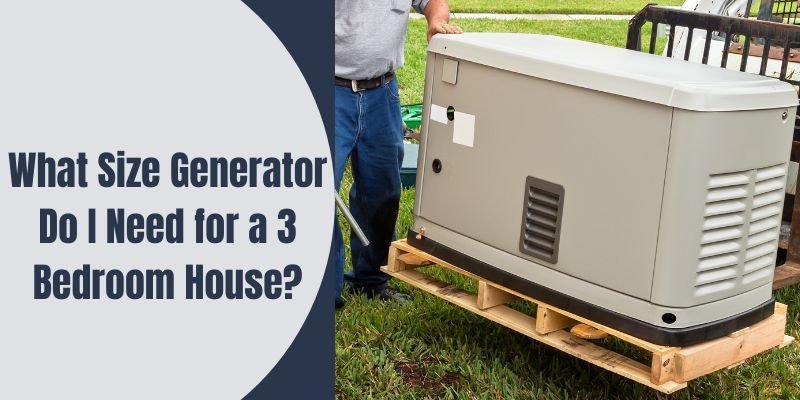Factors Affecting Generator Size: What Size Generator For A 3 Bedroom House

Choosing the right generator size for your 3-bedroom house is crucial to ensure you have enough power when you need it. It’s like picking the right size car for your family – you don’t want to be stuck with something too small, but you also don’t want to be driving around a gas guzzler that’s overkill. To find the perfect fit, you need to consider a few key factors.
Number of Bedrooms
The number of bedrooms in your house is a good starting point for estimating generator size. It’s not the only factor, but it gives you a general idea of how much power you’ll need. Think of it like this: more bedrooms usually mean more appliances and devices. So, if you’re looking to power a house with 3 bedrooms, you’ll likely need a larger generator than you would for a 1-bedroom apartment.
Types of Generators

Generators come in different shapes and sizes, each suited for different needs. You’ve got your portable ones, your standby ones, and your whole-house ones. Each of these has its own unique features and benefits, so choosing the right one for your needs is key.
Portable Generators, What size generator for a 3 bedroom house
Portable generators are the most common type of generator. They’re easy to transport and can be used in a variety of situations. These bad boys are perfect for camping, tailgating, or providing power during a power outage.
Portable generators are typically powered by gasoline or propane, and they have a power output ranging from 1,000 to 10,000 watts.
Standby Generators
Standby generators are designed to automatically provide power during a power outage. They are typically installed outside your home and are connected to your home’s electrical system.
Standby generators are usually powered by natural gas or propane, and they have a power output ranging from 5,000 to 20,000 watts.
Whole-House Generators
Whole-house generators are the largest type of generator. They are designed to power your entire home during a power outage. These guys are installed outside your home and are connected to your home’s electrical system. They’re often used in larger homes or homes with a lot of electrical appliances.
Whole-house generators are typically powered by natural gas or propane, and they have a power output ranging from 10,000 to 200,000 watts.
Comparison of Generator Types
Here’s a table that compares the pros and cons of each type of generator:
| Generator Type | Pros | Cons |
|—|—|—|
| Portable | Easy to transport, affordable | Limited power output, noisy, requires manual start |
| Standby | Automatic operation, reliable, quiet | More expensive, requires professional installation |
| Whole-house | Powerful, can power entire home, quiet | Most expensive, requires professional installation |
Generator Sizing and Calculation

To choose the right generator for your 3-bedroom house, you need to determine the total power consumption of your home. This includes everything from your appliances to your HVAC system. Once you know your power needs, you can calculate the required generator size.
Calculating Generator Size
To determine the appropriate generator size for your home, you need to consider the total power consumption of all your appliances and systems. This includes everything from your refrigerator and stove to your air conditioner and lights. The easiest way to calculate this is to add up the wattage of each appliance.
- Wattage: The wattage of an appliance is the amount of power it uses. You can find the wattage of your appliances on their nameplates or in their owner’s manuals.
- Amperage: You can also use amperage to calculate the power consumption of your appliances. Amperage is the amount of current that flows through an appliance. To calculate the wattage, you can use the following formula:
Wattage = Amperage x Voltage
- Power Factor: The power factor is a measure of how efficiently an appliance uses power. A power factor of 1 indicates that the appliance uses power very efficiently. Most appliances have a power factor of around 0.8.
Once you have determined the wattage of each appliance, you can add them up to find the total power consumption of your home. You should also factor in a safety margin of 20-30%. This will ensure that you have enough power to run all of your appliances even during peak demand.
Recommended Generator Sizes for Different House Sizes
The table below shows the recommended generator sizes for different house sizes and power demands:
| House Size | Power Demand (kW) | Recommended Generator Size (kW) |
|---|---|---|
| 3 Bedroom | 7-10 | 10-15 |
| 4 Bedroom | 10-15 | 15-20 |
| 5 Bedroom | 15-20 | 20-25 |
What size generator for a 3 bedroom house – Determining the right generator size for a 3-bedroom house depends on your energy needs. Consider the appliances you’ll run, like your refrigerator, HVAC system, and water heater. If you’re planning a renovation, you might also want to factor in the power required for tools, especially if you’re planning to refinish bathroom vanity countertop or undertake other projects.
Once you’ve assessed your needs, you can choose a generator that meets your requirements and ensures a smooth transition during power outages.
Determining the right size generator for a 3-bedroom house depends on your specific needs, but you’ll want to consider the appliances and electronics you’ll be powering. If you’re looking for more spacious living, perhaps a 3-bedroom apartment in Tallahassee, FL might be a better option.
3 bedroom apartments in tallahassee fl offer a variety of options, from modern complexes to charming historic buildings. Once you’ve settled on your housing choice, you can better assess your generator needs for your new home.